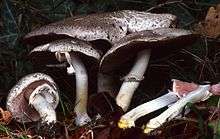Agaricus moelleri
Agaricus moelleri, also known as the inky mushroom,[1] or dark scaled mushroom,[2] is a large mushroom of the genus Agaricus. Most of the genus are excellent edibles, only a few are not, and this is one of the species that can leave some people with somewhat severe gastro-intestinal upsets.[2] It appears occasionally in most kinds of woodland, during late summer, in northern temperate zones.
| Agaricus moelleri | |
|---|---|
 | |
| Scientific classification | |
| Kingdom: | Fungi |
| Division: | Basidiomycota |
| Class: | Agaricomycetes |
| Order: | Agaricales |
| Family: | Agaricaceae |
| Genus: | Agaricus |
| Species: | A. moelleri |
| Binomial name | |
| Agaricus moelleri Wasser (1976) | |
| Synonyms | |
|
Agaricus placomyces Peck (1878) | |
| Agaricus moelleri | |
|---|---|
float | |
| gills on hymenium | |
| cap is flat | |
| hymenium is free | |
| stipe has a ring | |
| spore print is brown | |
| ecology is saprotrophic | |
| edibility: poisonous | |
Taxonomy
For many years Agaricus moelleri was erroneously accredited with the binomial Agaricus placomyces by some British authors. The epithet placomyces was in fact given to a North American species of Agaricus by Charles Horton Peck in 1878 (now known as Agaricus praeclaresquamosus A.E.Freeman 1979). The current binomial Agaricus moelleri was published in 1976 by the Ukrainian mycologist Solomon P. Wasser.[3]
Description
The cap has a greyish-brown patch in the centre and cold grey-brown scaling on the surrounding off-white background. It is 5 to 9 centimetres (2.0 to 3.5 in) in diameter, and yellows when bruised. It is ovate when young, flattening later.[1] The stem has a drooping ring, and stains yellow very easily when bruised, this colour then changes to brown over time. The stem flesh bruises yellow only faintly, and is more noticeable in the base. The gills are crowded, and free, as is typical for an Agaricus. They are pink on young specimens, but brown to black on older fruit bodies. The flesh is white and does not change colour on cutting. It is noted by some authors as smelling like ink, iodoform, sweat, or mouldy straw. The spores are 4–6 x 3–4 µm, and are elliptical.
A similar species occurring in North America, Agaricus praeclaresquamosus A.E. Freeman 1979, has several variants, some of which are larger.[4]
The rare Agaricus phaeolepidotus also has the iodoform, or ink smell, but has browner cap scales, and stains yellow less readily.[2]
Distribution and habitat
Agaricus moelleri is found in the temperate zones of the northern hemisphere. North America, Britain, and Europe, growing in mixed forests and woods. It is widespread, but can be locally rare, and favors rich alkaline woodland, or parkland.[2]
Edibility
In the same fashion as the yellow stainer (Agaricus xanthodermus), Agaricus moelleri can produce nasty gastro intestinal symptoms for some people but not others, when ingested.[2] It may be best to presume they are poisonous overall.
See also
- List of Agaricus species
References
- Roger Phillips (2006). Mushrooms. Pan MacMillan. ISBN 0-330-44237-6.
- Thomas Laessoe (1998). Mushrooms (flexi bound). Dorling Kindersley. ISBN 0-7513-1070-0.
- Wasser SP. (1976). "Species nova e genere Agaricus L. ex Fr. emnd. Karst". Novosti Sistematiki Nizshikh Rastenii. 13: 77–9.
- David Arora (1986). Mushrooms Demystified. Ten Speed Press. ISBN 0-89815-169-4.